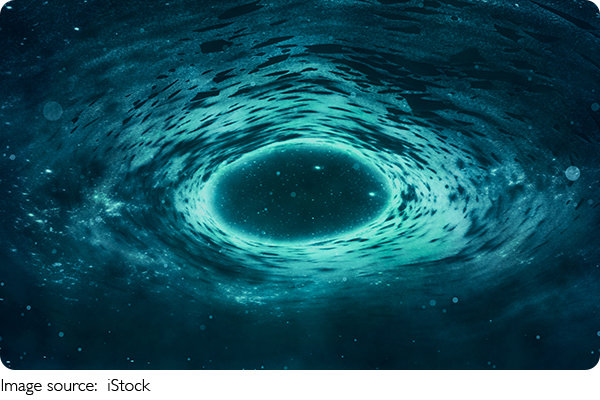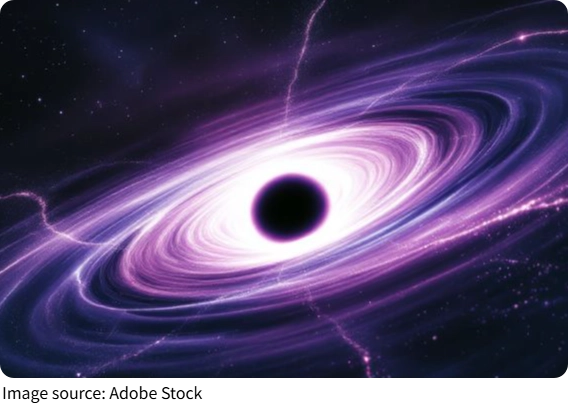Space's Ultimate Distorters

Most of us have heard that black holes are bottomless pits in space that "pull in everything." But is that really what they are? And how do they actually affect the universe around them? The real story is far more fascinating than just destruction.
Black holes are extreme objects that bend the rules of reality—literally. They distort space and time so much that light, gravity, and even the concept of "before and after" start to get fuzzy.
Let's walk through what's really happening at the edge of one of the strangest things in the universe.
What Is a Black Hole, Really?
At its core, a black hole is a region where gravity has become so intense that nothing—not even light—can escape. They're formed when a massive star collapses under its own weight after running out of fuel. The result is an incredibly dense point called a singularity, surrounded by a boundary known as the event horizon. Once something crosses that horizon, it's gone from our visible universe.
But here's the key: black holes aren't just vacuum cleaners in space. They're powerful deformers of the structure of space and time itself.
How Black Holes Bend Space
Imagine putting a bowling ball on a rubber sheet. The ball sinks into the fabric, and anything you roll nearby curves toward it. That's kind of what a black hole does—but instead of a rubber sheet, we're talking about spacetime, the invisible fabric that underlies our entire universe.
Black holes don't just curve spacetime.
They stretch it to the extreme:
1. Time slows down as you approach a black hole. If your friend were falling toward one, you'd see them move slower and slower, frozen near the edge. But from their perspective, time would feel normal—they wouldn't even notice the distortion.
2. Distances get warped. Space becomes so curved that paths twist inward, and light has to follow those curves. This is why black holes can "trap" light.
This warping effect is so strong near the event horizon that traditional physics starts to break down. Einstein's theory of general relativity tells us how this bending happens—but even it struggles to explain what occurs deep inside the black hole.
The Bending of Light: Gravity as a Lens
One of the weirdest and most beautiful results of black holes' power is something called gravitational lensing.
Light doesn't travel in straight lines near a black hole. Instead, it follows the curves of warped space. This causes light from objects behind a black hole to bend around it and reach us anyway. The black hole acts like a natural magnifying glass, creating warped, ring-like images of galaxies. Astronomers call these glowing rings "Einstein rings," and they're not just pretty—they help scientists detect and study black holes.
1. Stellar system mirages: Massive black holes in stellar system clusters can distort the light of galaxies behind them, showing multiple stretched images of the same stellar system.
2. First photo proof: In 2019, scientists captured the first actual image of a black hole's shadow using a planet-wide telescope network. What we saw was a bright ring of bent light around a dark center—the unmistakable fingerprint of a black hole.
Can Anything Escape? The Information Paradox
If black holes trap everything, what happens to the stuff they eat? This leads us to one of the biggest puzzles in physics: the information paradox.
According to quantum mechanics, information about physical systems can't be destroyed. But black holes seem to delete everything—matter, energy, and data alike. Stephen Hawking famously suggested that black holes could slowly leak energy back into space through Hawking radiation—but how the "information" gets out is still unsolved.
Here are two major competing ideas:
1. Information escapes with Hawking radiation: Some physicists believe subtle changes in this radiation could carry data out.
2. Information stays on the surface: Others argue that information is encoded on the event horizon like a hologram, never really lost but scrambled beyond recognition.
It's a major ongoing debate. And solving it might lead us toward a unified theory that connects gravity with quantum physics.
Are Black Holes Just Cosmic Monsters?
Despite their reputation, black holes aren't just destructive forces. They might even be essential to stellar system formation. At the center of nearly every large stellar system lies a supermassive black hole, millions or even billions of times the mass of our Sun. These giants may help regulate how galaxies grow and evolve.
Some scientists even speculate that black holes could act as windows to other universes, or that they might help us understand the very beginning of time.

So, what do you think—are black holes terrifying space monsters or misunderstood tools of the cosmos? They bend space, slow down time, twist light, and challenge our deepest scientific ideas. If that's not fascinating, what is?
Let us know what part of black holes surprises you the most—or which theory about them you find the most mind-blowing. There's still so much to discover out there, and every question we ask pushes us one step closer to understanding the universe.
-
 Elegant SoupsSimple Yet Sophisticated: Western Soups to Elevate Any Meal
Elegant SoupsSimple Yet Sophisticated: Western Soups to Elevate Any Meal -
 Sleep Affects Eye Health?Waking With Dry Or Puffy Eyes? Could Poor Sleep Be Hurting Your Vision?! What's The Connection?!
Sleep Affects Eye Health?Waking With Dry Or Puffy Eyes? Could Poor Sleep Be Hurting Your Vision?! What's The Connection?! -
 Sleeping With LightsDo You Sleep With the Lights On? Here's What It Might Secretly Be Doing to Your Body and Mind!
Sleeping With LightsDo You Sleep With the Lights On? Here's What It Might Secretly Be Doing to Your Body and Mind!